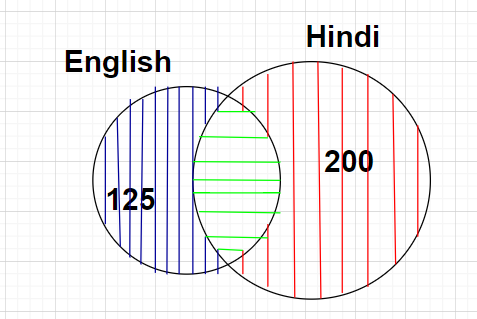
In a group of 500 people, 200 can speak Hindi alone while only 125 speak English alone. The number of people who can speak both Hindi and English is
$
{\text{A}}{\text{. 175}} \\
{\text{B}}{\text{. 325}} \\
{\text{C}}{\text{. 300}} \\
{\text{D}}{\text{. 375}} \\
$
Answer
613.5k+ views
Hint: Here, we will proceed by drawing the relevant Venn diagram according to the problem statement and then finding out the value of the unknown regions by visually analysing the diagram.
Complete step-by-step answer:

Given, there are total 500 number of people in the group who can speak either English or Hindi or both Hindi and English (this region is represented by all the three coloured lines which are blue, green and red lines in the figure or the complete region of the figure) i.e., $n\left( {E \cup H} \right) = 500$
Also given that 200 number of people can speak Hindi alone (this region is represented by red coloured lines in the figure) i.e., $n\left( {H{\text{ only}}} \right) = 200$
Also given that 125 number of people can speak English alone (this region is represented by blue coloured lines in the figure) i.e., $n\left( {E{\text{ only}}} \right) = 125$
We have to find the number of people who can speak both Hindi and English (this region is represented by green coloured lines in the figure) i.e., $n\left( {E \cap H} \right)$
Clearly from the Venn diagram shown, we can write
Total region which consists of all the coloured lines which includes blue, green and red coloured lines is equal to the sum of the region which consists of blue coloured lines, the region which consists of green coloured lines and the region which consists of red coloured lines.
$
\Rightarrow n\left( {E \cup H} \right) = n\left( {E{\text{ only}}} \right) + n\left( {E \cap H} \right) + n\left( {H{\text{ only}}} \right) \\
\Rightarrow n\left( {E \cap H} \right) = n\left( {E \cup H} \right) - n\left( {E{\text{ only}}} \right) - n\left( {H{\text{ only}}} \right) = 500 - 125 - 200 \\
\Rightarrow n\left( {E \cap H} \right) = 175 \\
$
Therefore, the total number of people who can speak both Hindi and English are 175
Hence, option A is correct.
Note: In this particular problem, the total number of people who can speak Hindi (this region is represented by two coloured lines which are red and green) is $n\left( H \right) = 200 + 175 = 375$ and the total number of people who can speak English (this region is represented by two coloured lines which are blue and green) is $n\left( E \right) = 125 + 175 = 300$.
Complete step-by-step answer:

Given, there are total 500 number of people in the group who can speak either English or Hindi or both Hindi and English (this region is represented by all the three coloured lines which are blue, green and red lines in the figure or the complete region of the figure) i.e., $n\left( {E \cup H} \right) = 500$
Also given that 200 number of people can speak Hindi alone (this region is represented by red coloured lines in the figure) i.e., $n\left( {H{\text{ only}}} \right) = 200$
Also given that 125 number of people can speak English alone (this region is represented by blue coloured lines in the figure) i.e., $n\left( {E{\text{ only}}} \right) = 125$
We have to find the number of people who can speak both Hindi and English (this region is represented by green coloured lines in the figure) i.e., $n\left( {E \cap H} \right)$
Clearly from the Venn diagram shown, we can write
Total region which consists of all the coloured lines which includes blue, green and red coloured lines is equal to the sum of the region which consists of blue coloured lines, the region which consists of green coloured lines and the region which consists of red coloured lines.
$
\Rightarrow n\left( {E \cup H} \right) = n\left( {E{\text{ only}}} \right) + n\left( {E \cap H} \right) + n\left( {H{\text{ only}}} \right) \\
\Rightarrow n\left( {E \cap H} \right) = n\left( {E \cup H} \right) - n\left( {E{\text{ only}}} \right) - n\left( {H{\text{ only}}} \right) = 500 - 125 - 200 \\
\Rightarrow n\left( {E \cap H} \right) = 175 \\
$
Therefore, the total number of people who can speak both Hindi and English are 175
Hence, option A is correct.
Note: In this particular problem, the total number of people who can speak Hindi (this region is represented by two coloured lines which are red and green) is $n\left( H \right) = 200 + 175 = 375$ and the total number of people who can speak English (this region is represented by two coloured lines which are blue and green) is $n\left( E \right) = 125 + 175 = 300$.
Recently Updated Pages
The number of solutions in x in 02pi for which sqrt class 12 maths CBSE

Write any two methods of preparation of phenol Give class 12 chemistry CBSE

Differentiate between action potential and resting class 12 biology CBSE

Two plane mirrors arranged at right angles to each class 12 physics CBSE

Which of the following molecules is are chiral A I class 12 chemistry CBSE

Name different types of neurons and give one function class 12 biology CBSE

Trending doubts
One Metric ton is equal to kg A 10000 B 1000 C 100 class 11 physics CBSE

Explain zero factorial class 11 maths CBSE

What is 1s 2s 2p 3s 3p class 11 chemistry CBSE

Discuss the various forms of bacteria class 11 biology CBSE

State the laws of reflection of light

Difference Between Prokaryotic Cells and Eukaryotic Cells




